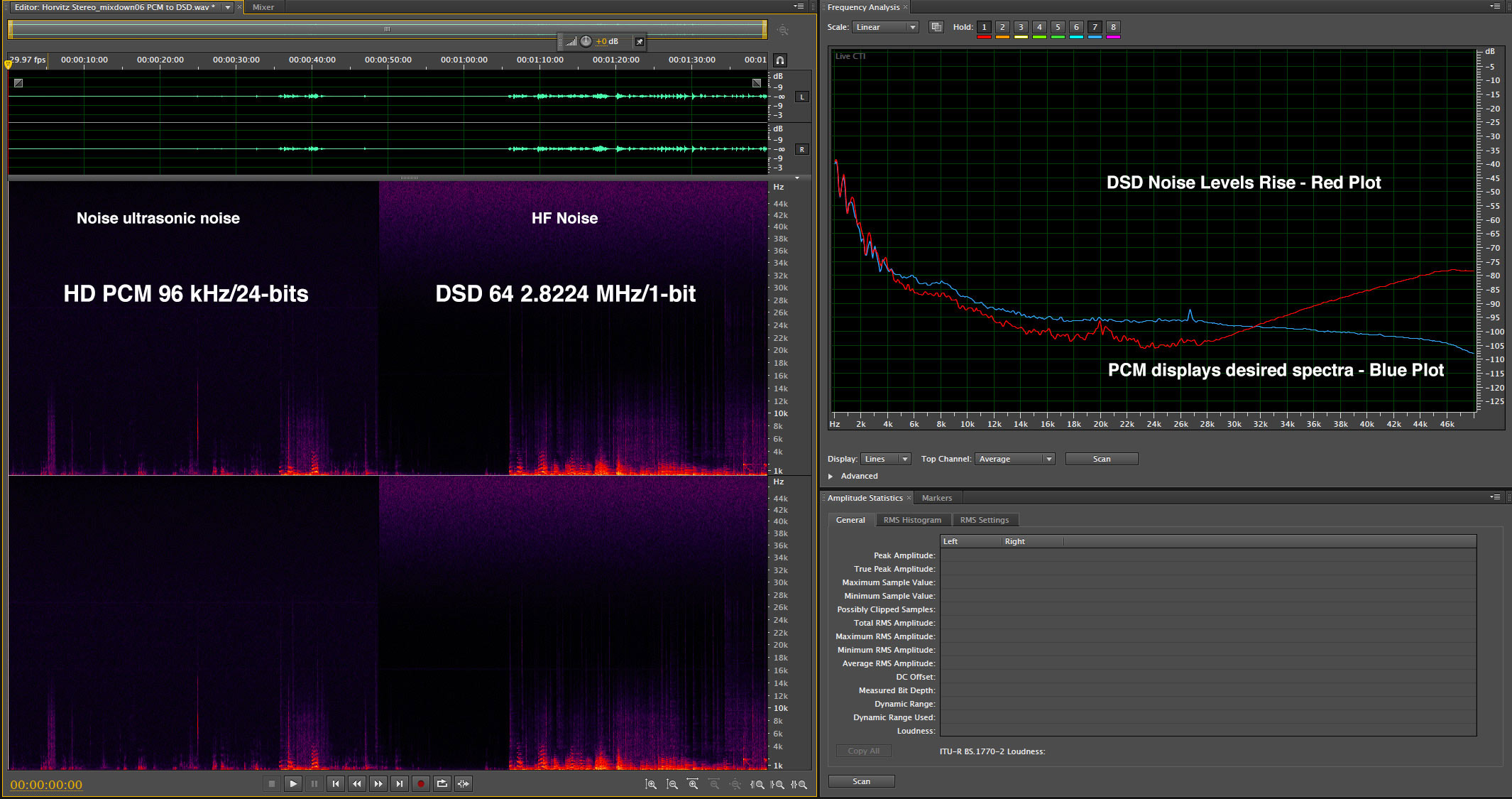Novice Professionals
As you all know, I read all of the comments posted on this site prior to approving them for everyone to see (I have never rejected a comment…only the spam goes to the trash). Most of the time they’re simply comments about the day’s post. However, sometimes they include a reference to an external website when something I’ve written is quoted. This morning I followed the thread back to Chris Connaker’s very popular Computer Audiophile site. The post is titled, “Mark Waldrep is claiming that PCM 24/96 is superior to DSD”, which is a guaranteed trigger for DSD advocates to begin pages of comments. Never mind that it’s true.
First, I’m somewhat dismayed that one of CA’s readers would lift my entire article and post it on Computer Audiophile. A reference to a post…fine, but taking the entire piece is an inappropriate overreach IMHO. The piece they “quoted” was about the Sound Liaison conversion of 96/24 PCM to DSD and the premium prices of the converted files. The headline about my claims of 96 kHz/24-bit PCM being superior to DSD 64 is absolutely true if you actually take a spectragraph of both formats and compare them. For example, take a look at the image below:
Figure 1 – The spectra of simlutaneous PCM and DSD recordings of the Wayne Horvitz Trio. Notice the ultrasonic noise in the DSD. [Click to enlarge]
There are many knowledgeable people contributing to the CA site. But there are also novices that chime in as “experts” with heavy handed criticism about things that they don’t really understand. An acknowledged hobbist recording engineer when asked about my recordings said this about my technique of miking a piano, “My advice? Go on his web-site and order one of his samplers. They have jazz, rock and some classical. They sound fine if you don’t care about stereo, because they are all multi-channel mono (he stereo mikes his pianos, but with both mikes under the piano’s lid, you end up with the low-end of the keyboard in the left speaker, and the high-end in the right speaker -Yeccchhh!)”
I’m pretty sure I know the ideal sound that George wants from his recordings and others…and obviously they don’t match my own. The traditional way to present a jazz band or classical ensemble if with minimal mikes located some distance away from the source. He’s entitled to his opinion. But his assessment of my recordings is lacking. I don’t even know what “multichannel mono” is but I’m sure that all of my releases aren’t produced that way. I use many stereo pairs of microphones because it’s the way our human auditory system works. My doctoral studies included a great deal of research on binaural hearing and the technologies best able to capture it. I was inspired by many of the things I learned during my research.
The inclusion of a discrete stereo mix for customers interested in two-channel stereo on my discs is a plus for stereo fans. Why would he say that I don’t care about stereo. I prefer surround but I don’t ignore stereo. And the whole discussion of miking a piano has been covered before (click here for an explanation of my process). I do use two stereo pairs close to the harp of the piano. George may not like the results but pianists and reviewers have raved about the sound I achieve. I’ll give more weight to them than a hobbyist recording engineer.
When I read comments that challenge my credentials or criticize my recordings, it’s unpleasant but it comes with the territory. It would have been nice to have Chris Connaker chime in with his thoughts on the system he heard in Chicago and the surround music that I played. Maybe next year.



Unfortunately nothing is sacred today,ethics has gone out the window or doesn’t exist.
As I’ve read your post/blog I believe the way Cosmo Matassa and others recorded and made those forever great recordings should be your approach because your capturing the moment not creating an event.
Good criticism, bad criticism, take it with a grain of salt, especially from self-proclaimed experts. If you want to stop others from stealing your words, put it in a limited access password-only section. I’ll still read it.
Thanks, I don’t want to restrict the posts…I would just hope that readers and other sites would respect the work of others.
All the graphs in the world are less important to me than what my ears have always told me about DSD; a somewhat veiled and soft presentation of music that has never been to my taste. Whether you said it or not Mark, there is no revelation in that CA forum thread heading than I have known since SACD entered my life many years ago
I agree that hearing is a critical component of evaluating a recording or playback system…but specifications and graphs do contribute to the process.
Far too many “audiophiles” never go out to venues to hear live music. I wouldn’t lose any sleep on reading any of their comments, good or bad.
Joe Whip wrote: “Far too many “audiophiles” never go out to venues to hear live music.” So true and I suspect one or two audiophile hardware manufacturers don’t listen to real music either; and then of course we have the magazine reviewers who have their “reference systems”. My reference has, and always will be, real musicians playing real music.
Irrespective of how the recording was done, the essence of the musical event should always be conveyed by a competent system.
I’m not in total agreement with the concept that the reference is live musicians in performance as a reference. There are many…dare I say most…commercial records that are completely conceived and realized as studio productions without consideration of live presentation.
I do some hobby recording myself. I love small acoustic ensemble’s recorded with two mics. Especially Blumlein and mid-side setups. I have done it both ways. Close multi-miking with care and two mics only. I was there to hear the original sound. I usually put the mic pair as close as I can get away with. To me it is no contest…..a mic pair easily wins such a comparison.
But that is to me.
My multi-miked recordings aren’t too bad either. For the 15 or so non-audiophiles I have let audition both versions every one of them preferred close miking. My processing of the multi-track recording is minimal. Level adjustments and EQ is all most of the time.
Like many audiophiles I love putting on a simple good recording and hearing the sense of space that is not my listening space and then hearing musicians playing within that space. Apparently most non-audiophiles (they are still music lovers and there are more of them than audiophiles) perceive the sound of space as noise that gets between them and the music. The music is what they want to hear. If it sounds like it was semi-transplanted to their listening room then fine. That spacious sense of air is between the music and them.
So I don’t share your opinion of the goal, and that is fine. I obviously wouldn’t throw the baby out with the bathwater. A good performance multi-miked with taste and care is something I would gladly enjoy just fine. A musical disaster sounding off with the most delicious sense of space is not something worth listening to. If nothing else, I think most music lovers are on your side.
Dennis…your methodology has been the preferred and standard operating procedure for many decades. It obviously works and can sound amazing. My choice to pursue an alternative path creates a different experience…less of sonic documentary and more of a hybrid approach. It worked for Windham Hill. Thanks.
I think one reason I prefer the sonic documentary approach is it simplifies my goal. If I was there to hear it, that is what I am shooting for in the result. Taking a different approach one needs more judgment, and experience. As a duffer recordist I need the simplicity. A professional with experience working on this full time has a much better chance of doing good recordings, and being a bit creative on the results than I would. So my goal being different was not meant as a slight in any way.
I also own some Windham Hill recordings and do find them very enjoyable.
Dennis, it sounds like you’ve enjoyed making recordings in a manner that works for you. I did the same thing for many hundreds of recordings and was always pleased with the results. Simplicity is something I strive for as well…for that reason I don’t overdub, I don’t use EQ or dynamics processing, I don’t add reverb, BUT I do mix the various pairs of microphones to create the stereo and 5.1 surround mixes (audience and stage). I find that the “sonic documentary” style is just too distant for my taste. Although, I know of more that a few customers that add additional reverb to my tracks. Cheers.
The propeller heads at CA have one objective…..justify their purchases. Steeped in pseudo knowledge they pare the science to fit baseless oxymorons. Half truths metastasize into the cottage industry that is DSD. Like SACD, they stand alone, let provenance reign.